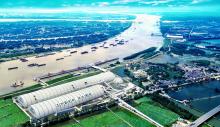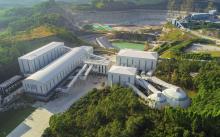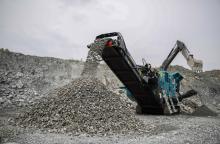Government investment in infrastructure projects is driving aggregates consumption, but a rush to strict new environmental quarrying standards has led to shortfalls in supply. Liam McLoughlin reports
Demand for aggregates in China remains very high and the trend is towards a further increase this year.
General aggregates consumption in the country was approximately 20 billion tonnes in 2018, according to the Chinese Aggregates Association (CAA). The association adds that, with three months of 2019 still to go, the figure for this year is expected to increase to more than 20 billion tonnes.
Aggregates produced in China include natural sand, natural gravel, manufactured stone, manufactured sand and recycled aggregates. As the main material in concrete, crushed stone is the most produced aggregate in China. Natural sand production is declining sharply due to greater government controls on extraction, says David Zhao, editor of China Aggregates Net, which specialises in Chinese aggregates market analysis.
Driven by China’s huge population and relatively low urbanisation level, Zhao says that aggregates annual demand is likely to remain high.
The high demand for aggregates is being driven mainly by heavy government investment in highway, subway and train infrastructure projects. These need high-quality aggregates from quarries that have been certified.
Major nationwide government initiatives that are providing demand include high-speed railways, expressways, and basic roads for the most remote villages. One of the largest current construction megaprojects is the 24km, eight-lane Shenzhen-Zhongshan bridge near Hong Kong that will connect the city of Shenzhen on the eastern side of the Pearl River Delta with the city of Zhongshan on the western side. Construction started in December 2016 and is due for completion in 2024.
Zhao says that infrastructure investment is playing an important role in stabilising the Chinese economy during the ongoing Sino-US trade dispute. In 2019 infrastructure investment in the country is increasing to RMB3.21 trillion.
In 1949 just 10.6% of the population lived in cities, according to Hu Youyi, president of the China Aggregates Association (CAA), but this had increased to 59.58% by 2018. “Now every year we build another Shanghai,” Hu says.
This ongoing high demand has come at the same time as major structural changes in the Chinese quarrying sector (intended to improve the environmental impact of quarries) have impacted supply levels. The rush to green standards has taken place over a two- to three-year period that could have taken decades in other countries, says Zhao. These factors have combined to cause dramatic fluctuations in aggregates prices.
Traditionally China has had a lot of smaller quarries and until quite recently there were more than 300,000 quarries in the country, according to Li Shunshan, president of NMS Industries, a mineral processing and quarrying company based in Jiangxi province.
He adds that these quarries are often very small, producing just 100 tonnes per hour.
The government is now pursuing a policy of having larger quarries and Li estimates that the number has been reduced to 60% of the previous figure at around 180,000 quarries. He adds that the government of President Xi Jinping wants to get cleaner air and the smaller quarries have been shut due to their environmental impact.
Environmental protection is now the key factor driving the Chinese aggregates industry upgrade, according to Zhao. “Every quarry has to take it very seriously otherwise the government will close it,” he adds.
Fang Libo, executive deputy general manager and director of SMB Industry and Technology Group, says that there are now much stricter standards for quarry and mine operators on dust and emissions.
“You also need to ‘re-green’ the site when you have finished extraction,” adds Fang, who is also executive director of the China Aggregates Association.
While the number of quarries has reduced, the output of the existing ones is getting much bigger. However, Li says the structural changes mean that there is a shortage of aggregates supply to meet the increasing demand.
“When you are constructing bigger quarries it takes time,” he adds. “You need to get a licence from the government and this takes a long time to be approved for their safety and environmental standards. It can take more than one year to get a licence to construct a quarry.”
He estimates that the overall price of aggregates has increased by up to three or four times over the last two years, with 2019 seeing the biggest increase so far at around 200%. He predicts that prices will continue to grow and should stabilise by 2021.
The CAA’s Hu says that the “irregular” regional price of aggregates around the country has caused problems. The difference in prices can be 10 to 20 times in different areas, and this has affected some infrastructure projects, Hu says.
Because of the demand for aggregates, production at Chinese quarries can be between 1,000 and 3,000 tonnes per hour, according to Li Shunshan, and is generally much higher than the US and Europe where rates can be around 500 tonnes per hour.
Li says that a lot of new players are trying to become involved in quarrying. “Even pavement companies want to open a quarry for the financial opportunities in the sector,” he adds. “I think most of the new players that enter will be large-scale companies from industries such as cement and engineering.”
The strict environmental policies will increase the importance of manufactured aggregates, according to Fang Libo.
“Five years ago a lot of sand extraction took place from the lakes and rivers around Shanghai, and the city had the lowest price for natural sand in China,” Fang says. “Because of environmental protection all of this is being shut down.”
He predicts that the majority of aggregates for road construction will come from manufactured aggregates.
The environmental restriction on natural sand extraction has pushed its price “insanely high”, according to China Aggregates Association secretary general Sun Weixing. He says this means it is imperative for the Chinese market to adopt machine-crushed sands for the supply of infrastructure projects.
“Many enterprises have already seen the prospects for crushed sand and have started the tooling of their crushed sands factories,” says Sun. “The development of crushed sands has become the inevitable trend for the future.”
Limestone is very much in demand for house construction and accounts for around 80% of aggregates production in China. “Road building needs harder rock and basalt aggregates and accounts for around 15%,” says Li.
In terms of equipment that is currently in demand among Chinese quarrying customers, Fang says that there are differences across the regions. Jaw crushers are popular in some areas due to their relatively low base costs, while elsewhere cone crushers find favour because of the long life of wear parts.
Gyrating/jaw crushers, cone crushers and VSI (vertical shaft impactor) crushers are a popular choice for newly built large quarries which have hard rocks in China, David Zhao says, while some large quarries with soft rocks select hammer crushers as the primary equipment.
“Cost is the most considered factor for private companies, while most state-owned quarries prefer well-known equipment with excellent performance and services,” Zhao adds. “And there is a rising demand for mobile crushing and screening equipment in demolish waste treatment and quarry operation.”
Fang Libo says that for crushing and screening plants, mobile is very popular in road-building projects while stationary plant is the most used in quarries.
Finnish company
“The Chinese market for mobile crushing and screening equipment is one of the fastest-growing markets in aggregates today,” said Markku Simula, president of the aggregates equipment business at Metso.
The new range will be produced by
Competition is very intensive among Chinese quarrying equipment suppliers, according to Li Shunshan of NMS Industries. “Companies like ours are going to Australia, the US and Africa to try to find opportunities,” he says. “Africa has the biggest potential for our crushing and screening machines, not only in aggregates production but also in metal mining.
“There is a lot of demand for our products in Africa – this year we’ve sold US$10m worth of equipment there, mostly crushers. We sell a lot in the Congo.”
Li believes his company can increase its sales in Africa and that it has a big advantage in price over competitors. “There is also opportunity for us in Europe and the Americas,” he adds. “We have recently sold a crusher in the US and also one in Finland.”
Chinese manufacturers are also developing their presence in other Asian markets.
The raw rocks extracted from the mountain are huge and heavy. After being cut and polished by skilled craftsmen, they are used for building decorations, tombstones and sculptures. Production reaches 100,000m3 per month, and the LiuGong loaders are responsible for all loading and transferring work of rocks at the quarry site.
China’s domestic cement output increased by 6.8% in the first six months of 2019 to 1,045 million tonnes.
Releasing the figures in a financial statement, Chinese cement and clinker producer DongWu said the national cement industry in H1 saw increases in both sales volume and prices. However, it added that the H1 2019 growth rate is lower than that for the first half of 2018.
DongWu says that growth in demand and compression in supply mean that the country’s cement and clinker stocks are at a medium-low level overall, ensuring that cement market prices are still at an “historically good” level.
It added: “Although the market pattern of strong demand in [the] south and weak in [the] north has not changed, the prices and supply and demand in the northern region represented by Beijing, Tianjin, Hebei and the surrounding areas have improved significantly compared with last year.”
Real estate investment in China saw an increase of 10.9% compared with H1 2018, driven by the growth of new construction areas and areas already under construction.
The central and local governments introduced measures that enabled the gradual recovery of infrastructure investment in H1 (particularly in the transportation segment) as compared with the end of last year.
These measures meant that national demand for cement was better than expected with a year-on-year increase of more than 5%. Growth was higher in the northern regions than in the south, according to Chinese industry news site dcement.com.
In H1 the average price for Portland (PO42.5) cement in China was RMB435 (€55.42) per tonne, a 4% year-on-year increase of RMB17 (€2.17) per tonne.
DongWu said that the general increase in both sales volume and price in China’s domestic cement industry in H1 meant that its group sales volume and operating income in the period both increased from H1 2018. In the first half of 2019, the group recorded profits from the cement segment of around RMB38.4m (€4.9m).
In terms of where the Chinese aggregates industry will be in ten years’ time, Zhao predicts there will be fast development and consolidation ahead. “Strict regulations wiped out many ‘traditional’ aggregate plants and strong companies are coming in,” he says. “Fierce competition is waiting for those advanced modern quarries and it may all end by some consolidation. Then we can call it a mature industry.”









